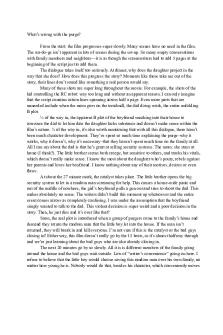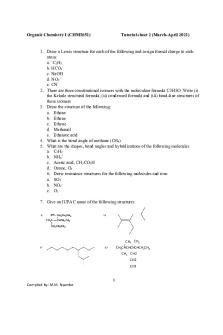Recycle bypass and purge Tutorial 2 PDF

| Title | Recycle bypass and purge Tutorial 2 |
|---|---|
| Course | Chemical Process Principles |
| Institution | University of the West of Scotland |
| Pages | 3 |
| File Size | 26.1 KB |
| File Type | |
| Total Downloads | 71 |
| Total Views | 145 |
Summary
Tutorial on Recycle, bypass and Purge questions by Dr. Zaki El-Hassan....
Description
Recycle, Purge and By-Pass Tutorial 2 1.
An evaporation-crystallization process is used to obtain solid potassium sulphate (K2 SO4) from an aqueous solution of the salt. The fresh feed to the process contains 19.6 wt% K2 SO4 . The wet filter cake consists of solid K2 SO4 crystals and a 40.0 wt% K2 SO4 solution, in a ratio of 10 kg crystals/kg solution. The filtrate, also a 40.0% solution, is recycled to join the fresh feed. Of the water fed to the evaporator, 45.0% is evaporated. The evaporator has a maximum capacity of 175 kg water evaporated/s. (a)
Assume the process is operating at maximum capacity. Draw and label a flowchart and do the degree-of-freedom analysis for the overall system, the recycle-fresh feed mixing point, the evaporator, and the crystallizer. Write in an efficient order (minimizing simultaneous equations) the equations you would solve to determine all unknown stream variables. In each equation, circle the variable for which you would solve, but don’t do the calculations.
(b)
Calculate the maximum production rate of solid K2 SO4 , the rate at which fresh feed must be supplied to achieve this production rate, and the ratio kg recycle/kg fresh feed.
(c)
Calculate the composition and feed rate of the stream entering the crystallizer if the process is scaled to 75% of its maximum capacity.
(d)
The wet filter cake is subjected to another operation after leaving the filter. Suggest what it might be. Also, list what you think the principal operating costs for this process might be.
2.
Ethylene oxide is produced by the catalytic oxidation of ethylene:
2C2 H4 +O2
2C2H4O
An undesired competing reaction is the combustion of ethylene:
C2H4 +3O2
2CO2 + 2H2O
The feed to the reactor (not the fresh feed to the process) contains 3 moles of ethylene per mole of oxygen. The single-pass conversion of ethylene is 20%, and for every 100 moles of ethylene consumed in the reactor, 90 moles of ethylene oxide emerges in the reactor products. A multiple-unit process is used to separate the products: ethylene and oxygen are recycled to the reactor, ethylene oxide is sold as a product, and carbon dioxide and water are discarded. (a)
Assume a quantity of the reactor feed stream as a basis of calculation, draw and label the flowchart, perform a degree-of-freedom analysis, and write the equations you would use to calculate: (i)
the molar flow rates of ethylene and oxygen in the fresh feed
(ii)
the production rate of ethylene oxide
(ii)
the overall conversion of ethylene
(b)
Calculate the quantities specified in part (a)
(c)
Calculate the molar flow rates of ethylene and oxygen in the fresh feed needed to produce ton per hour of ethylene oxide.
3.
Methanol is synthesized from carbon monoxide and hydrogen in a catalytic reactor. The fresh feed to the process contains 32.0 % CO, 64.0% H2 and 4.0% N 2 on molar basis. This stream is mixed with a recycle stream in a ratio 5 kmol recycle / 1 kmol fresh feed to produce the feed to the reactor, which contains 13.0 mole% N2. A low single-pass conversion is attained in the reactor. The reactor effluent goes to a condenser from which two streams emerge: a liquid product stream containing essentially all the methanol formed in the reactor and a gas stream containing all the CO, H2 , and N 2 leaving the reactor. The gas stream is split into two fractions: one is removed from the process as a purge stream, and the other is the recycle stream that combines with the fresh feed to the reactor. (a)
For a basis of 100 kmol fresh feed/h, calculate the production rate of methanol (kmol/h), the molar flow rate and composition of the purge gas, and the overall and single-pass conversions.
(b)
Briefly explain in your own words the reasons for including (i) the recycle stream and (ii) the purge stream in the process design....
Similar Free PDFs

Lect12 recycle bypass purge
- 13 Pages

The purge - script coverage
- 3 Pages

Tutorial work - 1 and 2
- 47 Pages

Tutorial 1 and 2 Tutor
- 7 Pages

Tutorial 2 questions and answers
- 2 Pages

Tutorial-2
- 1 Pages

Tutorial 2
- 3 Pages

Tutorial #2
- 2 Pages

Tutorial 2
- 1 Pages

Tutorial 2 - .....
- 3 Pages

Tutorial 2
- 3 Pages

Tutorial 2
- 2 Pages

Tutorial 2 - tut 2
- 5 Pages
Popular Institutions
- Tinajero National High School - Annex
- Politeknik Caltex Riau
- Yokohama City University
- SGT University
- University of Al-Qadisiyah
- Divine Word College of Vigan
- Techniek College Rotterdam
- Universidade de Santiago
- Universiti Teknologi MARA Cawangan Johor Kampus Pasir Gudang
- Poltekkes Kemenkes Yogyakarta
- Baguio City National High School
- Colegio san marcos
- preparatoria uno
- Centro de Bachillerato Tecnológico Industrial y de Servicios No. 107
- Dalian Maritime University
- Quang Trung Secondary School
- Colegio Tecnológico en Informática
- Corporación Regional de Educación Superior
- Grupo CEDVA
- Dar Al Uloom University
- Centro de Estudios Preuniversitarios de la Universidad Nacional de Ingeniería
- 上智大学
- Aakash International School, Nuna Majara
- San Felipe Neri Catholic School
- Kang Chiao International School - New Taipei City
- Misamis Occidental National High School
- Institución Educativa Escuela Normal Juan Ladrilleros
- Kolehiyo ng Pantukan
- Batanes State College
- Instituto Continental
- Sekolah Menengah Kejuruan Kesehatan Kaltara (Tarakan)
- Colegio de La Inmaculada Concepcion - Cebu


